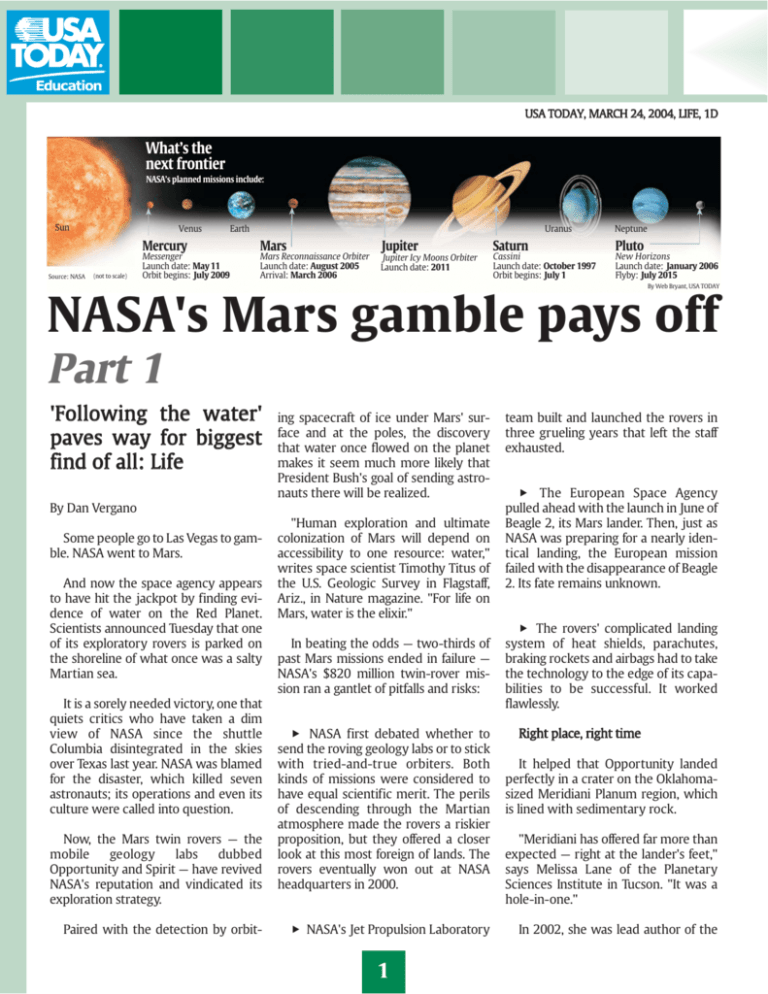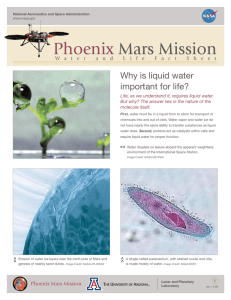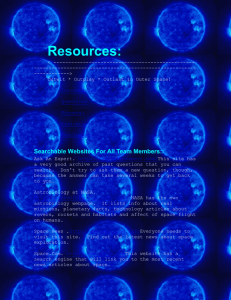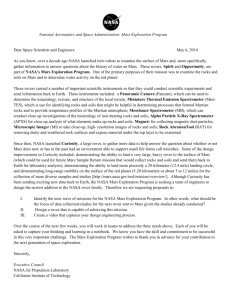Part 1 - USA TODAY Education
advertisement

USA TODAY, MARCH 24, 2004, LIFE, 1D What’s the next frontier NASA’s planned missions include: Sun Venus Mercury Source: NASA (not to scale) Earth Messenger Launch date: May 11 Orbit begins: July 2009 Uranus Mars Mars Reconnaissance Orbiter Launch date: August 2005 Arrival: March 2006 Jupiter Jupiter Icy Moons Orbiter Launch date: 2011 Saturn Cassini Launch date: October 1997 Orbit begins: July 1 Neptune Pluto New Horizons Launch date: January 2006 Flyby: July 2015 By Web Bryant, USA TODAY NASA's Mars gamble pays off Part 1 'Following the water' paves way for biggest find of all: Life ing spacecraft of ice under Mars' surface and at the poles, the discovery that water once flowed on the planet makes it seem much more likely that President Bush's goal of sending astronauts there will be realized. By Dan Vergano Some people go to Las Vegas to gamble. NASA went to Mars. And now the space agency appears to have hit the jackpot by finding evidence of water on the Red Planet. Scientists announced Tuesday that one of its exploratory rovers is parked on the shoreline of what once was a salty Martian sea. It is a sorely needed victory, one that quiets critics who have taken a dim view of NASA since the shuttle Columbia disintegrated in the skies over Texas last year. NASA was blamed for the disaster, which killed seven astronauts; its operations and even its culture were called into question. Now, the Mars twin rovers — the mobile geology labs dubbed Opportunity and Spirit — have revived NASA's reputation and vindicated its exploration strategy. Paired with the detection by orbit- "Human exploration and ultimate colonization of Mars will depend on accessibility to one resource: water," writes space scientist Timothy Titus of the U.S. Geologic Survey in Flagstaff, Ariz., in Nature magazine. "For life on Mars, water is the elixir." In beating the odds — two-thirds of past Mars missions ended in failure — NASA's $820 million twin-rover mission ran a gantlet of pitfalls and risks: u NASA first debated whether to send the roving geology labs or to stick with tried-and-true orbiters. Both kinds of missions were considered to have equal scientific merit. The perils of descending through the Martian atmosphere made the rovers a riskier proposition, but they offered a closer look at this most foreign of lands. The rovers eventually won out at NASA headquarters in 2000. u NASA's Jet Propulsion Laboratory 1 team built and launched the rovers in three grueling years that left the staff exhausted. u The European Space Agency pulled ahead with the launch in June of Beagle 2, its Mars lander. Then, just as NASA was preparing for a nearly identical landing, the European mission failed with the disappearance of Beagle 2. Its fate remains unknown. u The rovers' complicated landing system of heat shields, parachutes, braking rockets and airbags had to take the technology to the edge of its capabilities to be successful. It worked flawlessly. Right place, right time It helped that Opportunity landed perfectly in a crater on the Oklahomasized Meridiani Planum region, which is lined with sedimentary rock. "Meridiani has offered far more than expected — right at the lander's feet," says Melissa Lane of the Planetary Sciences Institute in Tucson. "It was a hole-in-one." In 2002, she was lead author of the Journal of Geophysical Research report that identified Meridiani Planum as a possible lake bed of the past. The composition of a bedrock outcrop confirms that water once soaked the rock layers, says rover mission chief scientist Steve Squyres of Cornell University. The landing site for Spirit, the Connecticut-sized Gusev Crater on the Mars research went into hibernation after the 1976 Viking mission landings. Designed to detect life, the landers found no organic molecules in samples of the soil. Then more recent findings reignited NASA's interest, such as the discovery four years ago by the orbiting Mars Global Surveyor of gullies that looked as if they had been carved by water. NASA’s Mars gamble pays off Article continued in next lesson. VOCABULARY D D D Discussion other side of Mars, was chosen because it was expected to reveal more signs of having been a lake bed. It turned out that any such deposits appear to have been buried by lava, although Spirit did find some mineral evidence of water. uWhat impact has the Mars expedition had on NASA’s reputation? uWhy did NASA choose Gusev Crater as the landing site for Spirit? uWhat made sending rovers to the planet such a risky proposition? atmosphere sedimentary rock bedrock mineral organic uWhy was the landing of Opportunity a “hole in one”? A A A A ctivity In small groups, you will be creating a scale model of our solar system using balls, newspaper, papier-mâché, or another material of your choice. Your model (at maximum) should be able to fit on a table inside your classroom. First, refer to the measurements listed below, and decide on an appropriate scale. Then, convert each diameter and distance to the measurement you will use for your model. Finally, use your conversions to construct each planet and the sun so that they represent the real objects. Using wire, string, etc., space the planets the correct distance from the sun. Ask another group to examine your model and determine the scale on which it is based. The scale we have chosen is ______________________________ =______________________________. Planet Earth Diameter (miles) Scale Distance from sun (miles) 7,926 92,897,000 88,846 484,000,000 Mars 4,220 142,000,000 Mercury 3,032 35,983,000 Neptune 34,504 2,800,000,000 1,485 3,670,000,000 Saturn 74,898 887,000,000 Uranus 31,763 1,780,000,000 7,521 67,200,000 Jupiter Pluto Venus The sun Scale 863,706 Source: www.jpl.nasa.gov and Encarta Numbers have been rounded. 2






